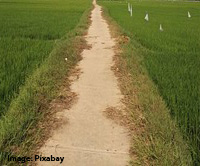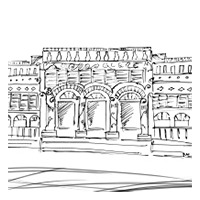
Our member, Ms S. Basu, gets a peep into human minds through the fan following for Maradona…
I have never been to the field to watch a real football game. My view of a match ...
Our member, Ms S. Basu, gets a peep into human minds through the fan following for Maradona…
I have never been to the field to watch a real football game. My view of a match has been from my verandah, looking down on a bunch of kids wallowing in muddy puddles or under the scorching sun, running after the elusive ball. Yet the divide between East Bengal and Mohan Bagan is a real one and loyalties in the mock battle are as per one’s origin in the east or west ofBengal. For that one need not know the niceties and intricacies of the game but needs to be able to enjoy the taste of Hilsa or Chingri, when they are served.
I could never really comprehend the madness for the Football World Cup in which India never came near to participation till my son pointed out that the supremacy of the game was established by the fact that one could get passionately involved even when your team was not participating. “Can you think of such a possibility with cricket?” He asked. “You just adopt a country through the World Cup and follow its fortunes till the end”. I came to adopt Argentina and thereby Maradona.
Come to think of it, Maradona did not require the media or any branding to create his image. It was his game and skill alone that made him the unalloyed legend that he was. It was rather unobtrusively that he wound his way through the players and punched the ball into the top of the goal. I was mesmerised by the stodgy figure in the blue and white striped No. 10 jersey easing his way through the field. Off the field, he went about quite unaware of the fuss around him.
My grandson is now a fan of Messi and a host of other players that I cannot recognise. However, along with his craze for contemporary players, the legend of Maradona continues. There are some other names like Don Bradman, Mohammad Ali and Tiger Woods, who live on irrespective of the game they play or the country to which they belong. Maradona, like them, gave me a ring side view of what humans are capable of.
Want to share your experience? Please mail your story to writetous@supportelders.com with your name

Gopinathpur, a village in the interiors of Bengal, several kilometers from the town of Mecheda was an idyllic place for a child to grow up in. Our member, Ms M. Seet, was raised there; her mind today is full ...
Gopinathpur, a village in the interiors of Bengal, several kilometers from the town of Mecheda was an idyllic place for a child to grow up in. Our member, Ms M. Seet, was raised there; her mind today is full of bittersweet memories. The rusticity was charming, the clay road from Mecheda to Gopinathpur did not bother the children, as they walked through the lush green paddy fields, extending for miles, mud houses, muddy roads… nothing mattered. Not even when they turned slushy during the monsoon.
In fact, they would often take a short cut through fields, walking on the narrow raised track between fields, enjoying the changing colours of the crops, wiling away time playing on the fields and also studying. She went to the local primary school. There were no benches and they sat in floor mats.
There was no electricity and it turned pitch dark after sunset. They were happy with the flickering hurricane lamps that every house had. The passing of her mother at a very early age made life a little difficult. Then her older sister got married and she had to take charge of her younger siblings. It was a struggle, managing both the home and studies at that tender age. There was no shortage of fun though. She clearly remembers the Rathh (chariot) festival in the village. Everyone competed to pull the rope of the chariot but it was no easy task. If it rained and the earth was slippery, they would invariably fall. That added to the fun and the excitement of the competition. There was also the Rathh’er mela (chariot fair) with all the little things on sale that was most exciting; the papad (thin, crisp, round flatbread) available at the fair was particularly special. It is all still fresh in her mind.
Then came the “Jatras” (folk theatre) in winter, which the villagers looked forward to. People finished all household chores early to reach the arena early and grab the front seats. All seating was on the floor, covered with floor mats.
Oh! The joys of simple living; she remembers it all today. The little money they had and yet the fulsome enjoyment.
(As narrated to Support Elders by our member)
Want to share your experience? Please mail your story to writetous@supportelders.com with your name

Her family Kalipuja at the Chowdhury zamindar bari (house) is something to remember for our member, Ms D. Dutta
Shingti Shibpur, a small town in Howrah district, was a land of many ...
Her family Kalipuja at the Chowdhury zamindar bari (house) is something to remember for our member, Ms D. Dutta
Shingti Shibpur, a small town in Howrah district, was a land of many zamindars (landed gentry) in Bengal during the British era. Born in the Chowdhury family, our member, Ms D. Dutta, had a luxurious and happy childhood in the joint family of the zamindar, with her 21 cousins and siblings. The children never understood the difference between cousins and siblings. There was one maid who looked after the children; the dal (lentil) and rice would be mixed on a big thali and the mashed potato kept on the side, as all the children were fed one by one. “After the first child had its share, the next would sit with the mouth wide open. I remember the fun of such shared meals. The milkman would comment that the children would all be fair as they had boiled potato and milk every day!!”
It is the memory of the Kalipujo, celebrated with traditional pomp every year, over the generations, which make for her most cherished memory. It was an open house and people from nearby villages poured in for the bhog (devotional offering of food, shared with the worshippers) at the zamindar bari. In the days of yore, 150 buffalos would be sacrificed in front of Ma Kali but the practice was abandoned following an accident. Sacrificial lambs were brought in thereafter. Over the years, the number has decreased to 25 but the sacrifice continues.
Only special priests could perform the puja; the “Agambagish”, who travelled from Khanpur to Shingti Shibpur to perform the puja for the zamindar family every year. The ritual was to place the Noibeddo (oblation) on the tongue of the enormous idol. The puja was just for a day but the elaborate arrangements to prepare the bhog and the meat cooked especially by the “thakur” (brahmin cooks) are still afresh in her mind.
The idol was so big that the pre-immersion ritual of ladies applying vermillion on the forehead of the deity was possible only with the ladies climbing a ladder to reach the forehead. Then the entire village would join the procession for the immersion.
“Today, after a long time, I had boiled and mashed potato and rice and milk, in spite of being diabetic. I told my help maid about the meals that I had with my siblings and cousins in our childhood!” (As told to Support Elders by our member)
Want to share your experience? Please mail your story to writetous@supportelders.com with your name

Ms S. Mukherjee, our member, grew up in Uttarpara and fondly recalls her encounters with the girls from the local zamindar family today, in a world when the 'zamindari' palaces are giving way to high rises.
Uttarpara, ...
Ms S. Mukherjee, our member, grew up in Uttarpara and fondly recalls her encounters with the girls from the local zamindar family today, in a world when the 'zamindari' palaces are giving way to high rises.
Uttarpara, some 20 kilometres from Kolkata, was once the land of zamindars, with many palatial houses in a typically rural Bengal setting. That was where our member, Ms S. Mukherjee, grew up, between Sheoraphuly and Uttarpara. Over the years she has witnessed the changing landscape with modern high-rises towering over the landscape today.
Ms Mukherjee looks back nostalgically at the enormous tract of land on which stood the “Zamindar Bari” of the Mukherjees by the river Hooghly with its sprawling garden and a huge portico in front of the palatial structure. “It was not possible to espy any family member from the road in front of the edifice”.
In right royal monarchic style, the zamindars controlled the peasantry, collecting taxes on behalf of imperial courts of the mughals, becoming even more powerful during the colonial era. Under the British, they shed their image as landed aristocracy and took on such titles as raja and maharaja, as conferred on them by the Raj.
Mukherjee Bari was special though. Jaykrishna Mukherjee, the zamindar, was an ardent social reformer, playing a major role in developing institutions of excellence in Uttarpara and improving civil amenities. He focused on road constructions and founded an amazing library in 1854, now known as Uttarpara Jaykrishna Public Library. This institution made a great contribution to enhancing access to knowledge in the region.
It was opened to the public on April 15, 1859 as the first free reading centre for the people; the first of its kind in Asia and renamed after Babu Jaykrishna, as he was popularly known. Famous people like Michael Madhusudan Dutt and Ishwar Chandra Vidhyasagar were amongst those visiting the library that had a collection of rare books.
Ms Mukherjee first studied at the Uttarpara Balika Vidyalaya, which was established by Ishwar Chandra Vidyasagar upon being requested by the Mukherjees, the only school at that time and later to the Uttarpara Girl's High School, where she had two girls from the zamindar's family girls as classmates. “They came in the family phaeton (a light four-wheeled horse-drawn carriage) but were perfectly down-to-earth and behaved like all other girls”. The only difference was they were never allowed to go out alone, even to school. They were close friends with whom she lost touch some time after they got married.
After the abolition of the zamindari system, post-Independence, these families broke up, their members scattering over different places, their source of living changing as did their lifestyles. Mukherjee Bari was sold and is to be redeveloped. All that remains are her memories.
Want to share your experience? Please mail your story to writetous@supportelders.com with your name

Our member, Ms B. Dasgupta, was born and brought up in Shillong, a quaint hill town that was the capital for composite Assam during the Raj. From the abode of clouds and the land of rolling hills she came ...
Our member, Ms B. Dasgupta, was born and brought up in Shillong, a quaint hill town that was the capital for composite Assam during the Raj. From the abode of clouds and the land of rolling hills she came to Calcutta after school, for higher education.
The picturesque landscape, fascinating pine trees, waterfalls and greenery around and a climate that suited even the British made for a charming city to grow up in for Ms Dasgupta, now 87. Thanks to the British influence, Shillong had a very ‘westernised’ culture and even girls cycled to school and spoke excellent English though her patents were very particular that she learnt Bengali just as well. “Under the strict supervision of my father I started learning Bengali, after completing my Senior Cambridge examination, I began to learn Bengali at home, tutored by a lady who started by making me write Pakhi shob korey rob, (the birds are chirping aloud), a poem for beginners”. She picked up fast and soon started reading Sarat Chandra Chattopadhyay and Bankim Chandra Chattopadhyay.
She also had her eyes set on doing geography at Calcutta’s Presidency College. There being no girl’s hostel in Presidency, her father managed to convince the Lady Brabourne administration to allow her to stay at the Brabourne’s hostel and study geography at Presidency. She could not study in Brabourne because geography was in the arts stream where Bengali was compulsory and she was afraid that her Bengali was not up to Bengal’s exacting standards. Presidency allowed her to study geography with science subjects.
The next obstacle was to convince the hostel administration, which insisted that girls going out be escorted by the hostel security, that she could be trusted to take the tram to Presidency and back. Trams were not crowded and buses had wonderful Punjabi drivers who were very helpful, especially to ladies.
She also had to adjust to the mindsets of her hostel mates that differed from hers: “I took it as a challenge and still believe that every individual must stay in hostel at least for few years just to be adaptable under all circumstances.” Today, she believes that her hostel stay gave her the resilience to deal with all circumstances that life would present. She did extremely well in college, with a 1st class first in geography honours from Calcutta University in 1953. However, she gave up studies after marriage and became a homemaker so that she could look after her family. That was the trend in those days, something unheard of now!
Over the years, Calcutta has become Kolkata and gone through a massive transformation. She finds nothing the same today; nothing that matches her college day memories.
Want to share your experience? Please mail your story to writetous@supportelders.com with your name

